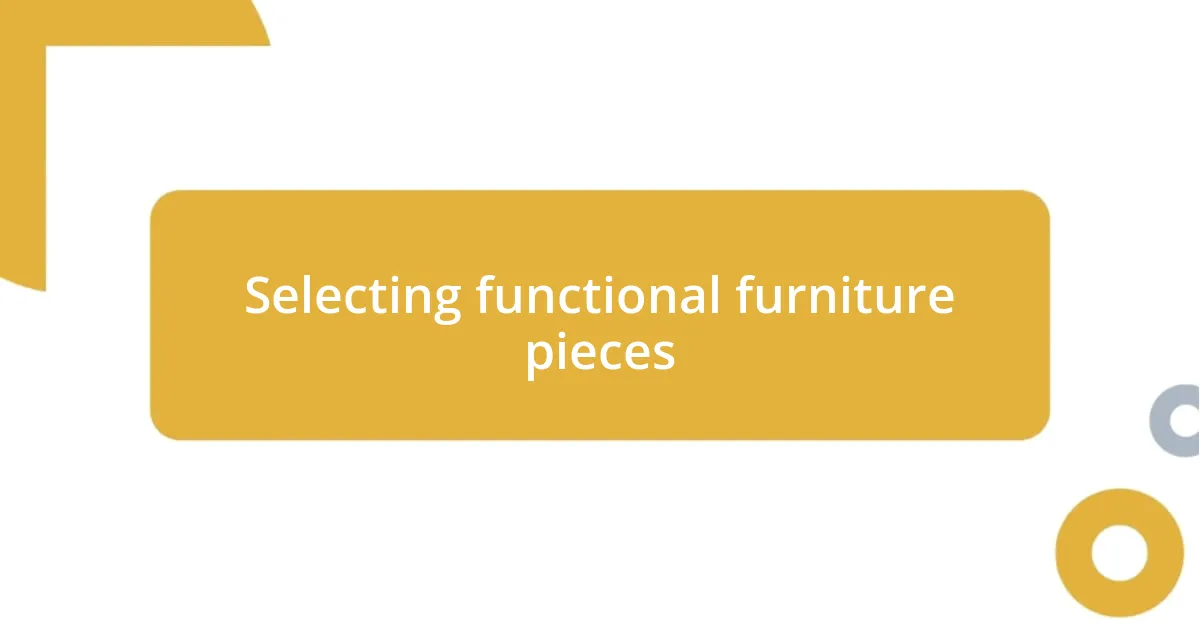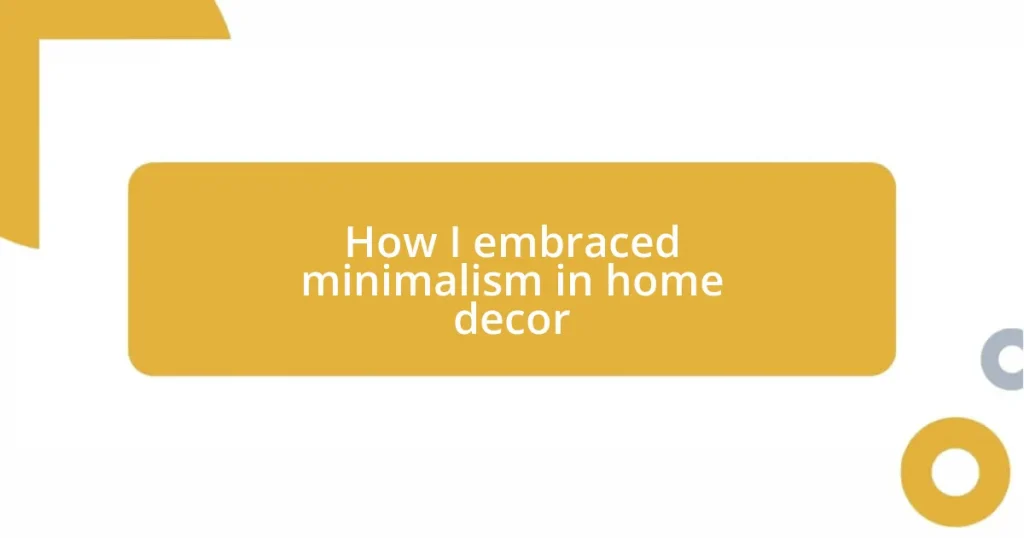Key takeaways:
- Minimalism emphasizes simplicity and intentionality, focusing on functionality and beauty to create a peaceful living space.
- Choosing a neutral color palette transforms the atmosphere, enhances natural light, and unifies diverse decor styles.
- Incorporating meaningful decor items, such as personal souvenirs and handmade crafts, enriches the space and reflects personal identity.
- Maintaining a minimalist lifestyle involves ongoing mindfulness, decluttering regularly, and adopting practices like the “one in, one out” rule.

Understanding minimalism principles
At its core, minimalism is about embracing simplicity and intentionality in your living space. I remember the moment I decided to part with my cluttered collection of knick-knacks. It was as if a weight lifted off my shoulders—I felt lighter, both physically and emotionally. Have you ever experienced that freeing sensation when you let go of things that no longer serve you?
The guiding principles of minimalism encourage us to focus on what truly matters: functionality and beauty. When I started examining each item in my home, I began to appreciate the elegance of open spaces and the calm they bring. It prompted me to ask, “Does this piece enhance my life?” By frequently evaluating my belongings, I found myself curating a space that reflects my values rather than my possessions.
Another crucial aspect of minimalism is the idea of mindfulness. It’s about making deliberate choices and appreciating the quality of what you have. I recall investing in a few beautiful, handcrafted items that I truly cherish. The act of choosing less, but choosing wisely, turned my home into a sanctuary that nurtures creativity and peace. Isn’t it amazing how the right elements can transform your environment?

Identifying clutter in your space
When I embarked on my minimalism journey, the first step was identifying the areas in my home that felt chaotic. It was surprisingly challenging; I had to confront not just the physical items but also the emotional ties attached to them. One afternoon, I decided to tackle my overflowing closet. As I pulled out clothes I hadn’t worn in ages, a wave of nostalgia washed over me. But then, I reminded myself that those pieces, while once loved, no longer contributed to who I am today.
To help pinpoint clutter in your space, here’s a straightforward approach:
- Assess each room: Stand in each room and notice where your eyes gravitate. Are there items making you feel overwhelmed?
- Make a list: Write down everything that feels out of place or unnecessary. This helps in visualizing the clutter.
- Evaluate regularly: I’ve found that setting a monthly reminder to assess my space keeps clutter at bay. It’s a simple practice that yields great results.
- Consider your emotions: How do certain items make you feel? If you sense negativity or indifference, it might be time to let them go.
By being mindful of what’s around you, you pave the way for a more intentional living space.

Choosing a neutral color palette
Choosing a neutral color palette is one of the most transformative steps I took in my home decor journey. When I swapped out vibrant colors for soft greys, whites, and beiges, the atmosphere shifted dramatically. It was as if the walls began to breathe, creating an open and calming ambiance that instantly made my space more inviting.
I remember nervously painting my living room a light taupe, unsure if it would feel too dull. To my surprise, it became the perfect backdrop for occasional pops of color through plants and artwork. This subtle palette not only provides versatility but also enhances natural light, making rooms feel larger and more airy. Isn’t it fascinating how a few shades can completely alter your perception of a space?
The beauty of a neutral color palette lies in its ability to unify diverse decor styles. I found that neutral tones allow me to play with textures and materials, making my home feel cohesive without overwhelming visual noise. By choosing a steady foundation of subdued colors, I’ve been able to layer in various elements—from wooden furniture to woven textiles—each piece having its moment to shine without competing for attention.
| Neutral Color Shades | Benefits |
|---|---|
| Beige | Warm and inviting; pairs well with almost any accent color. |
| Grey | Modern and sleek; complements both cool and warm tones. |
| White | Bright and clean; enhances natural light and makes spaces feel open. |
| Soft Taupe | Grounded and sophisticated; adds warmth without being overpowering. |
| Light Greys | Encourages a calming atmosphere; versatile for changing decor styles. |

Selecting functional furniture pieces
Selecting functional furniture pieces was a game-changer for me when I embraced minimalism. I vividly recall buying a large coffee table that doubled as storage. At first, it felt like a splurge, but it quickly became my favorite piece. It holds books, blankets, and even art supplies, keeping my living room tidy while serving as a focal point for gatherings. Have you ever thought about how often you use certain furniture? Choosing pieces that serve multiple purposes can really transform your space.
I urge everyone to consider the daily activities in each room when selecting furniture. For instance, I opted for a sleek, extendable dining table. It was perfect for my small apartment but could expand when friends came over. This adaptability not only reflects my lifestyle but also ensures I’m not crowding my space with large, unused furnishings. Can you imagine how liberating it feels to know that every piece you own is necessary?
Sustainability also entered my decision-making. I remember when I found a beautiful second-hand chair—slightly worn but bursting with character. It not only added uniqueness to my decor but also aligned with my values of reducing waste. Selecting functional furniture pieces that tell a story or serve a purpose goes beyond aesthetics; it truly enhances both my home and my life. How does your furniture reflect your personality and lifestyle?

Incorporating meaningful decor items
Incorporating meaningful decor items has truly transformed my space into a gallery of cherished memories. I’ve hung my grandmother’s hand-stitched quilt on a prominent wall, and every time I walk past it, I can’t help but feel her love surround me. It brings a warmth to the room that generic art simply couldn’t match. Have you ever found that one piece that just resonates with your heart?
Another moment that stands out was when I decided to display travel souvenirs in a shadow box. Instead of keeping them hidden away, I chose a few select items from my adventures—like a tiny Eiffel Tower and a brightly colored seashell—and organized them thoughtfully. Each piece tells a story, sparking conversations with guests. It’s amazing how objects laden with personal history can evoke emotions and foster connections, isn’t it?
I further embraced this philosophy by featuring handmade pottery from a local artisan. Initially, I took a chance on a single vase, but I quickly realized it spoke to my desire for uniqueness. The textures and imperfections make it feel alive, as if it carries the energy of its creator. Choosing decor items that reflect personal tastes not only enriches the aesthetic but also envelops my home in a sense of identity. What meaningful items do you have that tell your story?

Creating a serene atmosphere
Creating a serene atmosphere is all about simplicity and intention. I remember transitioning to a soft color palette in my home, specifically choosing light blues and gentle grays. The shift not only calmed my space but also my mind. Have you ever noticed how colors can profoundly impact your mood?
I also embraced natural light as a core element of tranquility. When I started clearing clutter from my windowsills, I was amazed at how inviting the sunlight felt as it poured into my living room. It seemed to breathe life into the space and created an open, airy vibe. Isn’t it incredible how something as simple as opening the curtains can transform your environment?
Lastly, I incorporated plants to enhance the serenity of my home. Adding a few potted succulents and a calming bamboo plant brought nature indoors, contributing to a sense of balance and peace. Each morning, I take a moment to water them, and it’s become a meditative practice that grounds my day. How do you infuse nature into your living space?

Maintaining your minimalist lifestyle
Maintaining a minimalist lifestyle requires ongoing mindfulness in my everyday choices. For instance, I revisit my belongings periodically, evaluating whether they still serve a purpose or spark joy in my life. It’s a cathartic experience to declutter and donate items that no longer resonate with me, which leaves space for new, meaningful possessions. Have you ever felt a rush of relief from letting go of things you didn’t truly need?
I’ve also learned to embrace the “one in, one out” rule, where for every new item I bring home, I let go of another. This practice has drastically reduced the urge to accumulate unnecessary things. Just the other day, I found myself drawn to a beautiful handmade journal. After much thought, I decided to part with an old notebook I no longer used. It felt right, allowing something new to take its place while keeping my space uncluttered and intentional. How do you balance new additions to your home?
Moreover, curating my daily routines has become essential in sustaining my minimalist approach. I consciously choose to spend my time on activities that reflect my values, like creating art or enjoying a walk outdoors. This adds depth and fulfillment to my life, steering clear of the excess that can often creep in. What intentional routines can you incorporate to enrich your minimalist lifestyle?













